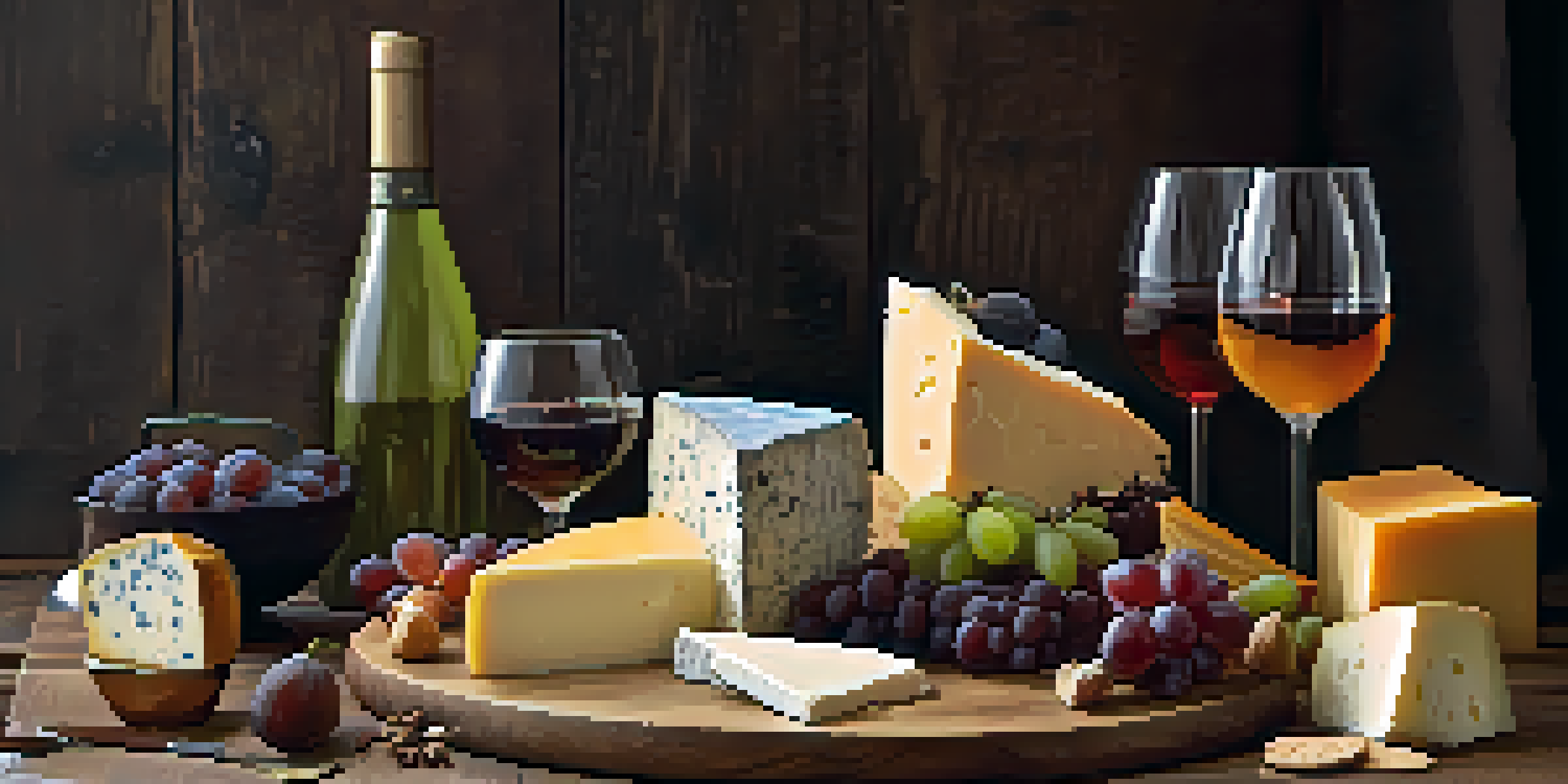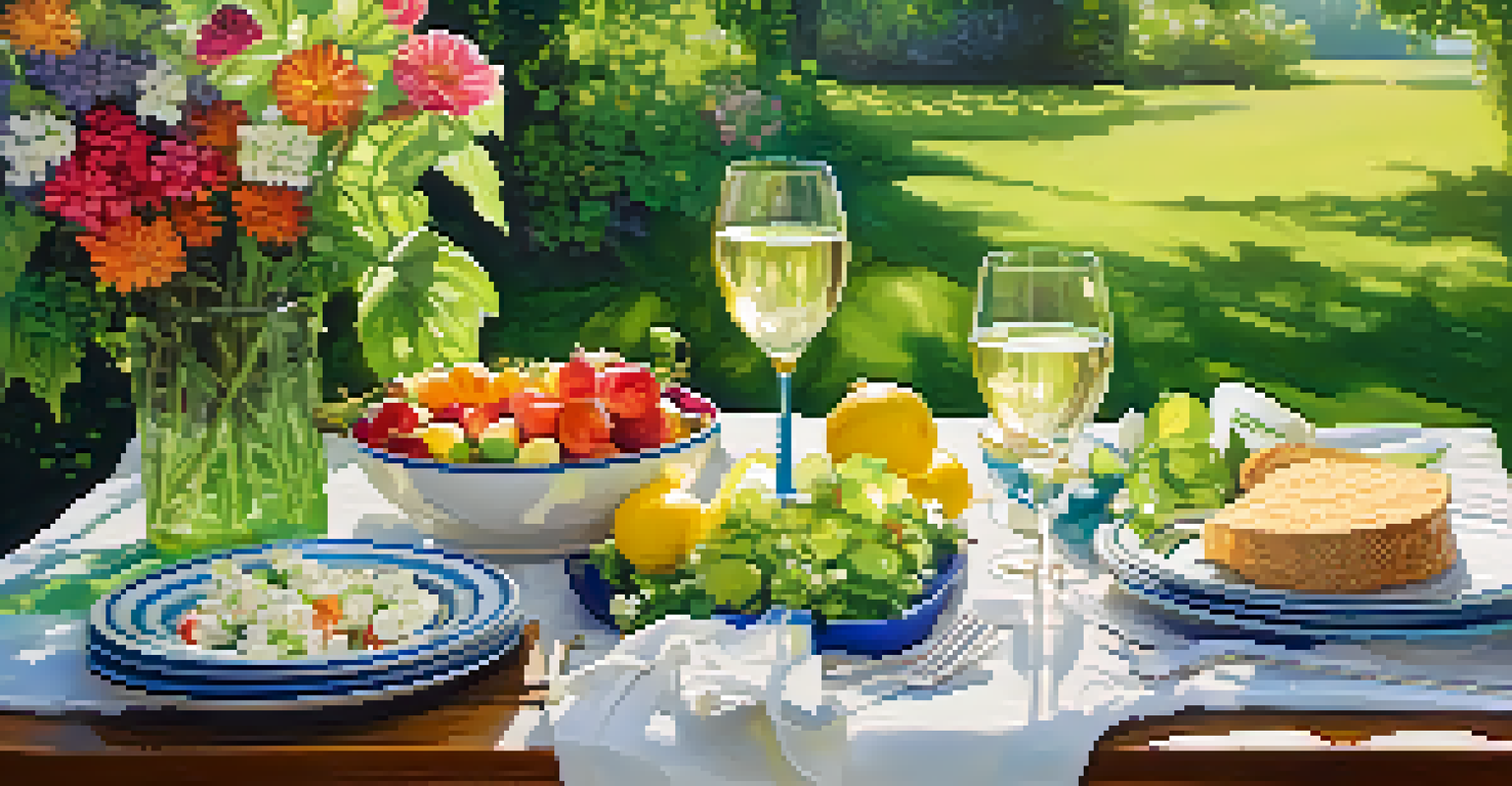Wine and Cheese Pairing: Elevating Your Luxurious Spread

Understanding the Basics of Wine and Cheese Pairing
Wine and cheese pairing is more than just a delightful combination; it's an art that enhances the flavors of both. To start, it's essential to recognize that different wines and cheeses have unique characteristics that can complement each other. For example, a creamy Brie pairs beautifully with a fruity Chardonnay, creating a harmonious balance on your palate.
Wine is sunlight, held together by water.
The fundamental rule is to consider the intensity of both the wine and cheese. A robust blue cheese might overpower a delicate Pinot Grigio, while a bold Cabernet Sauvignon can stand up to a sharp aged cheddar. This balance of flavors is key in creating a luxurious spread that impresses your guests.
Don’t hesitate to experiment! While there are classic pairings, your personal palate plays a significant role. The joy of discovering new combinations can turn a simple gathering into a memorable experience.
The Role of Texture in Pairing Choices
Texture is a crucial factor in wine and cheese pairing that often gets overlooked. The creaminess of a cheese can enhance or contrast with the body of a wine, making the experience more enjoyable. For instance, a rich, creamy cheese like Camembert can beautifully complement the crisp acidity of a Sauvignon Blanc.

Similarly, hard cheeses such as Parmigiano-Reggiano can be paired with a full-bodied red, like a Malbec, to create a satisfying mouthfeel. The interplay between smooth and rough textures can elevate the tasting experience, inviting your guests to savor each bite and sip.
Art of Wine and Cheese Pairing
Wine and cheese pairing enhances flavors, requiring attention to their unique characteristics and intensity.
When hosting, think about providing a variety of textures. Mixing soft, semi-soft, and hard cheeses with different styles of wine will not only create visual appeal but also keep your guests intrigued and engaged.
Classic Wine and Cheese Pairings to Try
Some pairings have stood the test of time for good reason. A classic example is the combination of sharp cheddar with a bold Cabernet Sauvignon. The richness of the cheese complements the tannins in the wine, creating a robust flavor experience that both novices and connoisseurs can appreciate.
Cheese is milk's leap toward immortality.
Another timeless pairing is goat cheese with Sauvignon Blanc. The wine's zesty acidity cuts through the creaminess of the cheese, providing a refreshing contrast that’s perfect for warm gatherings. This combination exemplifies how opposites can attract in the world of flavors.
Don’t forget about dessert! A sweet dessert wine like Sauternes pairs wonderfully with blue cheese, offering a delightful balance of sweetness and saltiness that can be a show-stopper at the end of any meal.
Seasonal Pairings for Every Occasion
Seasonality plays a significant role in wine and cheese pairing. In the warmer months, lighter wines and fresh cheeses are more appealing. Think of a refreshing Riesling paired with a tangy feta salad, perfect for summer picnics or garden parties.
As autumn rolls in, rich, earthy flavors come into play. Pairing a full-bodied Merlot with a nutty Gruyère makes for a comforting fall evening. These seasonal choices create a sense of warmth and nostalgia, enhancing your luxurious spread.
Seasonal Pairing Matters
Seasonality influences pairing choices, with lighter options favored in summer and robust flavors in winter.
Winter invites heartier options, where you can indulge in aged cheeses and robust wines. A bold Syrah with a rich blue cheese can create a cozy atmosphere perfect for holiday gatherings, celebrating the flavors of the season.
Exploring Unconventional Pairings
While classic pairings are a great starting point, don’t shy away from unconventional combinations. Sometimes, the most surprising pairings yield delightful results. For example, a fruity sparkling wine can pair wonderfully with a tangy aged Gouda, creating a refreshing contrast that surprises the palate.
Another intriguing option is to explore spiced wines, like mulled wine, paired with spiced cheeses. The warmth and complexity of these flavors can create a unique tasting experience that captivates your guests and encourages conversation.
Embracing a spirit of adventure can lead to discovering hidden gems in the world of wine and cheese. Challenge yourself and your guests to think outside the box, and you might just stumble upon your new favorite pairing.
The Importance of Presentation in Your Spread
Presentation is key when it comes to elevating your wine and cheese spread. A beautifully arranged charcuterie board can make even the simplest of pairings feel luxurious. Use a variety of colors, textures, and shapes to create an inviting display that encourages guests to dig in.
Incorporate garnishes such as fresh herbs, seasonal fruits, or nuts to add visual interest and enhance flavors. For example, pairing grapes with Brie not only looks appealing but also adds a sweet element that balances the creaminess.
Explore Unconventional Combinations
Venturing beyond classic pairings can lead to surprising and delightful flavor experiences.
Don’t forget about the serving vessels! Using wooden boards or slate platters can add a rustic charm, while elegant glassware for the wine will elevate the entire experience. The goal is to make the act of pairing feel as special as the flavors themselves.
Final Tips for Perfect Pairings
As you embark on your wine and cheese pairing journey, remember a few key tips to ensure success. Start by tasting each component separately to understand their unique flavors before combining them. This will help you appreciate how they interact with one another.
Additionally, don’t rush the process. Allow your guests to savor each pairing and discuss their thoughts. This creates a more engaging experience and can lead to interesting conversations about flavors and preferences.

Lastly, trust your instincts! There are no hard and fast rules in the world of pairing. What matters most is that you and your guests enjoy the experience, so have fun experimenting with different combinations to find what pleases your palate.